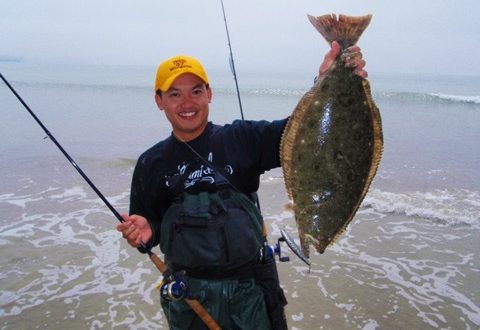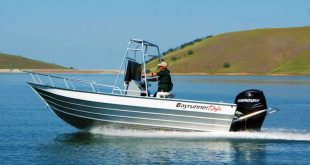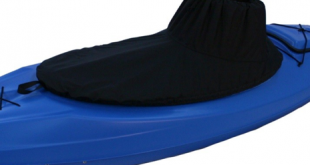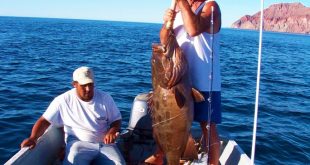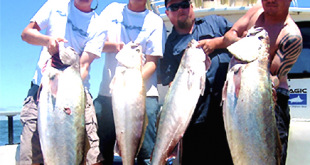Often referred to as ‘lenguado’ in Baja California, this oversized member of the flounder family can grow to over 60 pounds and is eclipsed in size only by its giant cousins, the northern Pacific and Atlantic halibuts, which can often reach weights of several hundred pounds.
Because there is no minimum size limit for taking these coveted fish in the waters of Baja California, it is always important to exercise restraint and remember that halibut generally must be over 20 inches in length before they can have an opportunity to participate in their first spawning season.
These flat, opportunistically aggressive predators are masters of camouflage. Their coloration will often change from dark brown to golden sandstone, depending on their cover, and they can deftly wiggle under the loose sand and lay motionless with little more exposed than the two eyes on the topside of its body. Suddenly, when a smaller, unsuspecting fish swims by, the halibut explodes forth with open jaws and a flurry of pointed, slashing teeth to devour its prey.
WHEN TO FISH
During spring through late fall, this was one of my favorite target species. Fishing for the California Halibut along Baja’s Pacific coast can be exceptional; especially in the various sandy, inshore areas that are excellent spawning ground for this species. Since these months are ones that tend to spark interludes of the halibut’s reproductive activities, those windows of time are usually most productive for the anglers who seek them out. Bays, such as Bahia de Todos Santos and Bahia San Quintin are also good places to find halibut. Schools of forage fish like such as smelt and anchovies are found in these areas and help to attract larger fish that move in seasonally to spawn.
HOW TO FISH
While fishing for lenguado using natural baits, it is not unusual to experience many short or missed bites. This situation can be addressed by using a ‘trap rig’. To construct a trap rig, a small treble hook is tied to the end of a 12 to 20 pound test fluorocarbon leader approximately 25 inches long and a single, live bait hook is then attached about 4 to 5 inches up from the treble. The leader is then tied to the middle eye a 3-way swivel, and 2 to 4 to 6 ounce torpedo sinker on a 5-inch leader is attached to the bottom eye with a clip swivel. Tie the line coming from your pole and reel to the 3rd eye of the swivel, and the trap rig is now complete and ready to use. Place one prong of the treble hook in the tail of the baitfish and the live bait hook through its nose.
WHAT TO FISH WITH
Live bait is one of the most efficient methods for catching halibut, either from a boat or onshore. Top smelt are one of the halibut’s favorite meals, and can be caught around rock jetties, pilings and marina docks by chumming with very small bits of bread, and then using a ‘Lucky Joe’ or ‘Sabiki’ type bait rig to hook them. Smelt are much hardier than anchovies, and can stay alive for a longer period of time when kept in a bait bucket or tank. The same bait rigs are also effective in taking small mackerel, which are a prime offering for bigger flatties.
Catching your own bait may not be practical, and if that’s the case, another option is to buy fresh dead sardines at a local fish market, or you can simply use salted anchovies from a bait & tackle store.
Halibut can also be taken on 3 to 8 inch plastic swimbaits in colors like blue or green, which resembles local forage fish such as the smelt, sardine or anchovy. They also attack plastic grubs of a similar length, with the best colors generally being chartreuse, orange or green. Grubs in smoke or clear colors with high metal flake content are also effective.
TECHNIQUE
When fishing from a beach or rocky outcropping, gently cast your rig out as far as possible onto the sandy bottom then let it move along with the tidal flow. When fishing from a boat, always lower live or dead bait rigs to the bottom slowly to avoid them from becoming tangled by too quick of a descent.
When a bite occurs, gently lift the tip of your pole until weight or movement is detected then set the hook with a light touch. Keep pressure on the fish throughout the retrieve, but make sure that your drag is not set too tight. Remember, halibut have relatively soft mouths, which can easily cause the fish to be lost if anglers become overly aggressive.
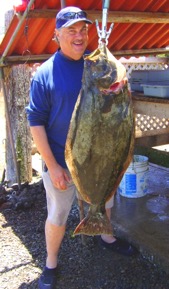
A TASTY ENDING
The California halibut, Paralichthys californicus, is one of the most avidly pursued gamefish on Baja’s northern Pacific coast and is highly prized as a gourmet delicacy. When properly cleaned, it can yield up to 70% of its body weight in mild, delicate fillets.
To get the highest yield from these tasty fish, use a very sharp knife and begin the filleting process by cutting a lengthwise line down the middle of the halibut’s back. Then carefully separate each of the two sections of meat from the skeletal structure directly below them with evenly measured incisions that scrape cleanly across the bones. After removing the skin from each of those fillets, turn the fish over and perform the same procedure on its white underbelly.
Once you have dressed out the halibut fillets for cooking, one of my all-time favorite ways to prepare them is to lightly coat each piece in flour, shaking off any excess. Dip them in beaten egg yolk, and then dredge in crushed Macadamia nuts. Make sure that each piece is covered completely. Place the fillets in a buttered baking casserole, and then drizzle each fillet with 1 tablespoon of the melted butter. Bake on the center rack of a preheated, 450-degree oven for 10 to 15 minutes. Serve with a tossed salad, fresh veggies and lemon wedges. Provecho!
 Baja Review A community newspaper serving Ensenada, Valle de Guadalupe, and Rosarito in Northern Baja California
Baja Review A community newspaper serving Ensenada, Valle de Guadalupe, and Rosarito in Northern Baja California
